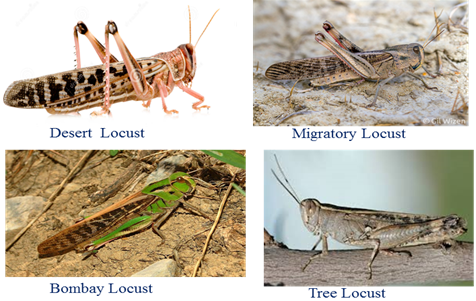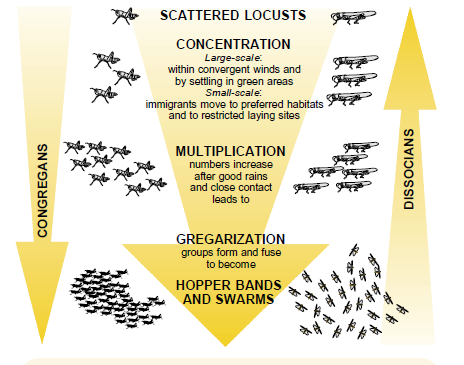Overview about Locusts
Overview about Locusts
Introduction
Historically, the Desert Locust has always been a major threat to man’s well-being. The Desert Locust is mentioned as curse to mankind in ancient writings viz. Old Testament-Bible and the Holy Koran. The magnitude of the damage and loss caused by the locusts is very gigantic beyond imagination as they can cause starvation its being a polyphagous feeder. An average small locust swarm eats as much food in one day as about 10 elephants, 25 camels or 2500 people. A swarm the size of Delhi will consume the same amount of food in one day as every inhabitant in Rajasthan or Madhya Pradesh in one day. Locusts cause damage by devouring the leaves, flowers, fruits, seeds, bark and growing points and also by breaking down trees because of their weight when they settle down in masses.
Important species of locusts in India
There are 10 important species of locusts in the world, out of these four types of locust are recorded in India viz.,
- Desert locust (Schistocerca gregaria F.) is the most destructive of them

- Migratory locust (Locusta migratoria L.)
- Bombay Locust (Nomadacris succincta L.) and
- Tree locust (Anacridium rubrispinum B.B.).
Biology of Desert Locust
The Desert Locust has three distinct stages: (i) egg, (ii) hopper and (iii) adult.
- Egg : Eggs are laid in pods in moist sandy soil at a depth of about 10-15 cm at an interval of 7–10 days. Gregarious females usually lay 2-3 egg pods having an average of 60-80 eggs/pod. Solitarious females lay 3-4 times having 150-200 eggs in average. The rate of development of eggs depends on soil moisture and temperature, but in general it is about two weeks. No development takes place below 15°C. The incubation period is 10–12 days when the optimum temperature is between 32– 35°C.
- Hopper : After incubation is complete, the eggs hatch and wingless nymphs (hoppers) emerge. There are 5 instars in gregarious and 5-6 instars in solitarious hoppers. In each instar, there is a growth and change in characteristic coloration.
- The rate of development of hoppers depends on temperature. It takes 22 days when the mean air temperature is hot say about 37°C and may be delayed up to 70 days when the mean temperature is below 22°C. In general, it takes about six weeks from hatching to fledging, or about one week per instar.
| 1st Instar | Newly hatched are white but turns black in 1-2 hours. |
| IInd Instar | Head is larger and pale colour pattern is conspicuous. |
| IIIrd Instar | Two pairs of wing buds projects on each side of thorax |
| IVth Instar | Colour is conspicuously black and yellow. |
| Vth Instar | Colour is bright yellow with black pattern. |
- Adult : The 5th instar nymph molts into adult stage. This change is called 'fledging' and the young adult is called a 'fledgling' in which its wings are still soft and cannot fly. After a few days, the wings harden and sexual 'immature adult' is capable of flight. The immature adult stage is most injurious and capable of long distance travel. Under optimal conditions the adult may mature in 3 weeks and under cooler and drier conditions, it may take up to 8 months. In general, however, it usually takes about 4 weeks before an adult is ready to reproduce. If vegetation dries out, the adults will leave the area and fly with the wind (downwind) in search of green vegetation and favorable breeding conditions. Solitarious adults fly for only a few hours at night while gregarious adults (swarms) fly during daylight.
Young immature gregarious adults are pink in color but older ones become dark red or brown in cold condition. On maturation, gregarious adults become bright yellow. Males mature before females. Oviposition commences within two days of copulation.
The mature female drills hole at a depth of 8-10 cm in moist sandy soil, oviposit thrice at weekly interval about 1000 egg pods/sq.m area. Adults fly in swarms and migrate in millions from country to country or from place to place. The adult swarms move at a speed of 12 to 16 kmph.

Locust Phases
| Characteristics | Solitary phase | Gregarious phase |
|---|---|---|
| Behavior | -Do not form groups or swarms -Roost, bask, feed and move as individuals -Hoppers move short distance, adults fly as individuals at night |
-Form persistent and cohesive groups, bands and swarm -Roost, bask, feed and move together -Very mobile, fly as swarms by day. Hoppers move in band. |
| Colour | -Hoppers uniformly green in early instars but may be brown in last two instars. -Adult pale grayish brown, buffer peach coloured. Males change to pale yellow on sexual maturation. -Female show no colour change on maturation at low density. |
-Hoppers have black pattern on yellow or orange background -Adults rosy pink on fledging, darkens with age to grayish or brownish red then to yellow on sexual maturation. Males are brighter. |
| Morphometrics | F/C Male 3.75 and above Female 3.85 and above E/F Male 2.025 or below Female 2.075 or below |
F/C Male 3.15 or below Female same as above E/F Male 2.225 and above Female 2.272 and above |
| Note: C = Width of head, E = Length of forewing, F = Length of hind femur, measuring Unit in milimetre | ||
Breeding Season
In all, there are three breeding seasons for locusts (i) Winter breeding [November to December], (ii) Spring breeding [January to June] and (iii) Summer breeding [July to October].
India has only one locust breeding season and that is Summer breeding. The neighboring country Pakistan has both spring and summer breeding.
Source : Directorate Of Plant Protection, Quarantine & Storage
Last Modified : 6/12/2020
The Article provides information about Antioxidant...
This topic provides information about 20th Livesto...
This topic deals with information related to Anxie...
This topic provides information about Sim Card Swa...
